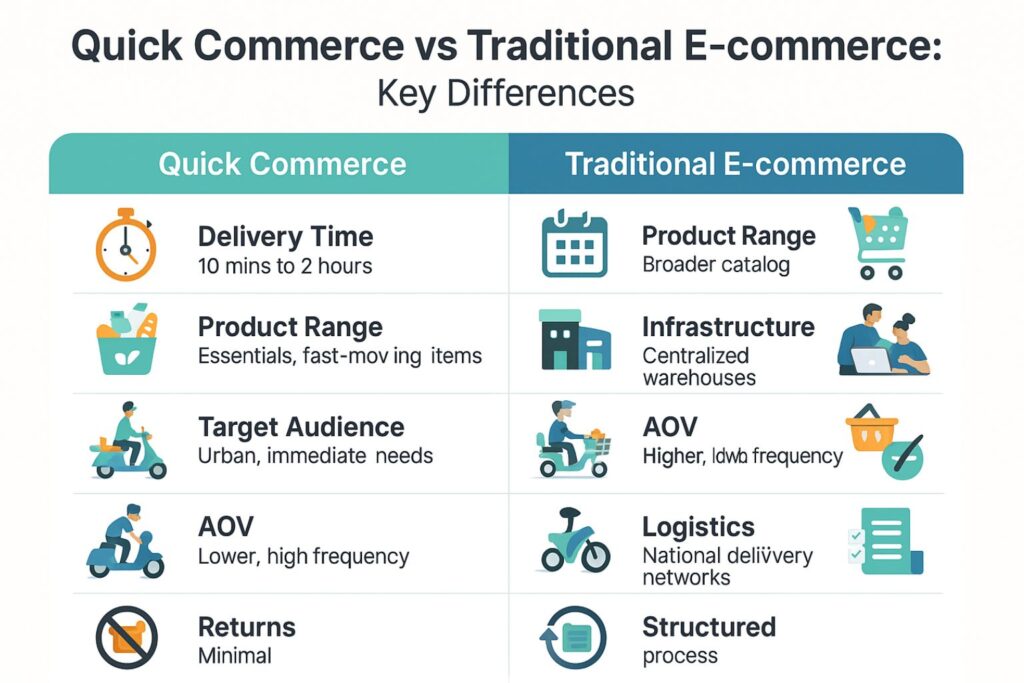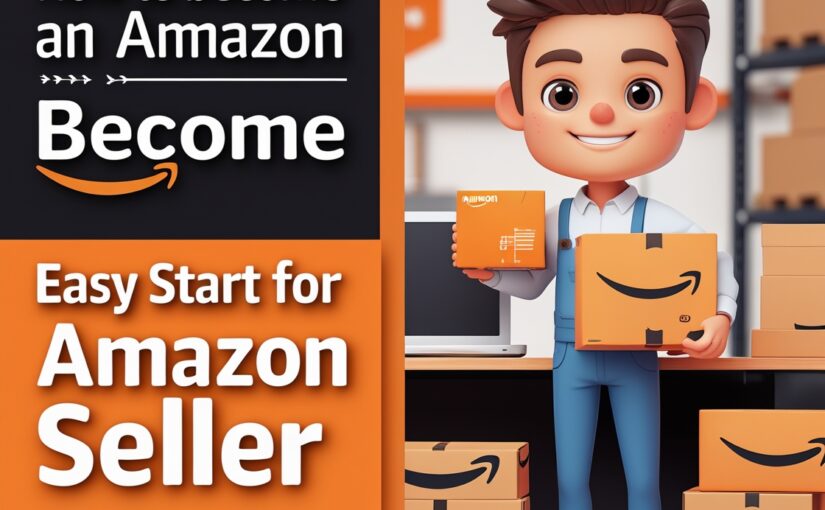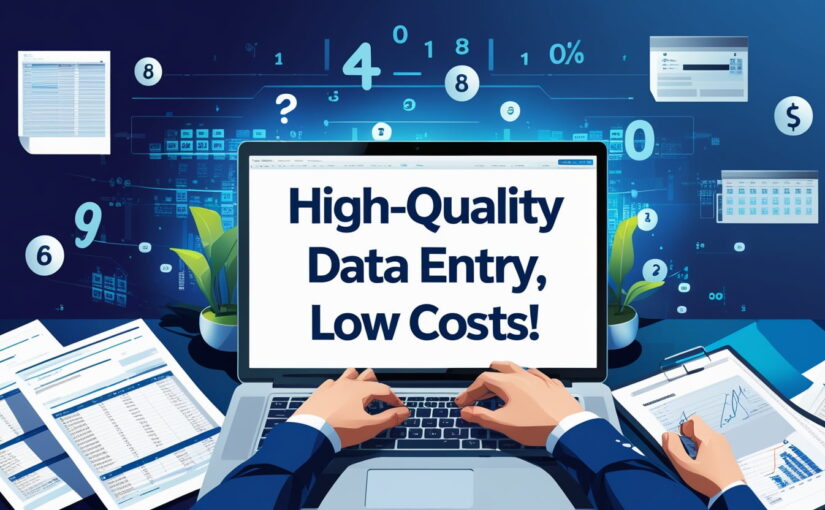The rapid development of Q-commerce has shifted the e-commerce landscape, especially in high-velocity regions such as India. Meeting the needs of burnt-out urban consumers, Q-commerce or delivery e-commerce has become a linchpin of retail logic.
The rapid delivery of goods from sellers’ locations in tantalizingly short intervals of 10 minutes to 30 minutes has transformed consumer behavior. For e-commerce sellers, adapting to hyper-fast delivery infrastructure by 2025 is not a choice but a minimum threshold of competitiveness in the industry.
Powered by insights from market movers and trends, this article hypothesizes practical solutions for e-commerce sellers to capitalize on Q-commerce utilizing Amazon’s for-hours as a case study and providing recommendations for optimized operations and guaranteed success.
Understanding Quick Commerce in 2025
Quick trade, or q-commerce, is an evolution of traditional e-commerce that prioritizes ultra-speedy shipping of essentials, commonly within 10 hours.
Unlike traditional e-commerce, which may take days, Q-commerce caters to instant needs—assume groceries, private care objects, or small electronics—through hyperlocal logistics and micro-warehouses referred to as darkish stores.
The Indian Q-trade market is projected to attain $five.5 billion by the end of 2025, growing at a compound annual growth rate (CAGR) of approximately sixty percent from 2023 to 2028. This explosive boom is pushed by way of busy city existence, increasing cellphone penetration, and a cultural shift towards convenience.
For e-commerce sellers, quick commerce offers both opportunities and challenges. The speed and comfort that outline structures like Zepto, Blinkit, and Swiggy Instamart require sellers to rethink inventory control, logistics, and consumer engagement.Meanwhile, giants like Amazon and Flipkart are entering the fray with offerings like Amazon Hours (equal-day or speedy slot-based totally total shipping) and Flipkart Minutes, intensifying competition.
To succeed, sellers must align their strategies with the unique demands of Q-commerce while leveraging the strengths of these marketplaces. This is where Amazon Listing Services play a crucial role in supporting your quick commerce goals.
Optimizing your product listings on Amazon ensures your essentials appear in relevant “Amazon hours” searches, rank excessively in cellular-first shopping reviews, and attract impulse buyers seeking out instantaneous transport. Effective Amazon Listing Services help with keyword studies, SEO-pushed content, and particular categorization, ensuring your product aligns with Amazon’s Q-commerce algorithms and customer expectations.
Additionally, properly managed listings enhance buy box eligibility for same-day shipping, real-time inventory syncing, and pricing automation—all of which might be important in brief trade’s speedy-paced environment. By combining Q-commerce logistics with optimized Amazon listings, e-commerce dealers can capitalize on both marketplace visitors and ultra-speedy shipping developments, driving conversions whilst building patron loyalty in an increasingly number of aggressive landscape.
Quick Commerce vs Traditional Delivery E-commerce
| Aspect | Quick Commerce | Traditional E-commerce |
| Delivery Time | 10 mins to 2 hours (“Amazon hours”) | Same-day to 7 days |
| Product Range | Essentials, fast-moving items | Broader catalog |
| Infrastructure | Micro-fulfillment, dark stores | Centralized warehouses |
| Target Audience | Urban, immediate needs | Broader, planned purchases |
| AOV | Lower, high-frequency | Higher, lower frequency |
| Logistics | Hyperlocal, bike delivery | National delivery networks |
| Returns | Minimal | Structured process |

Speed vs Selection:
- Quick Commerce prioritizes speed and convenience over extensive product variety.
- Traditional delivery e-commerce prioritizes variety with lower delivery urgency.
Infrastructure:
- Q-commerce requires dark stores or micro-fulfillment centers within delivery radii.
- Traditional e-commerce operates with large regional hubs for cost-efficient bulk movement.
Consumer Behavior:
- Q-Commerce addresses urgent, high-frequency needs.
- Traditional e-commerce serves planned purchases like electronics, clothing, or furniture.
Profitability:
Quick Commerce has lower margins but higher repeat orders, while traditional e-commerce has higher AOV but lower order frequency.
Returns:
Returns are minimal in Q-commerce, especially for perishables, reducing operational complexities.
Takeaway:
Sellers must adjust inventory, delivery promises, and marketing strategies to match Quick Commerce realities while maintaining traditional channels for planned purchases.
Key Marketplaces & Players in Quick Commerce
Understanding the principal gamers in quick trade is critical for e-commerce dealers looking to faucet into this marketplace. Each platform has distinct strengths, delivery fashions, and goal audiences, which dealers can leverage to optimize their reach and income.
Zepto
Known for its promise of 10-minute deliveries, Zepto focuses on ultra-rapid grocery and necessities shipping. It operates over 300 dark shops strategically positioned close to dense residential clusters in metro towns like Bengaluru, Delhi, and Mumbai. Zepto’s AI-pushed logistics and actual-time stock control make certain precision in order success, making it a top preference for dealers of fast-shifting consumer items (FMCG).
Blinkit (Zomato)
Blinkit leads the Indian short commerce market with a 46% share by way of gross merchandise cost (GMV). Its hyperlocal darkish save approach, with over 639 micro-warehouses, enables deliveries in as low as nine mins. Blinkit’s integration with Zomato’s transport network and its consciousness on excessive-demand city regions make it a powerhouse for sellers concentrated on millennials and Gen Z.
Flipkart Quick/Minutes
Flipkart has entered short trade with its Minutes service, released in 2024, supplying 10–14-minute deliveries in pick towns like Bengaluru, Delhi, and Mumbai. Unlike the competition, which focuses totally on groceries, Flipkart Minutes consists of electronics and fashion, catering to a broader target audience. Its low minimum order cost totally free delivery (₹99), appeals to rate-sensitive clients.
Amazon Fresh:
Amazon’s quick trade services, frequently called Amazon hours, consist of identical-day or two-hour shipping slots via Amazon Fresh, with a pilot for 10–15-minute deliveries (Amazon Now/Tez) released in Bengaluru in 2025.With three hundred dark stores deliberate by means of year-cease, Amazon leverages its Prime membership base and considerable logistics to compete with Blinkit and Zepto. Sellers gain from Amazon’s significant client base and records-driven insights.
BigBasket’s BB Now
BB Now supplies groceries within 15–30 minutes, supported with the aid of 500–600 dark stores across 35 towns. Backed by means of Tata Digital, BB Now integrates with BigBasket’s legacy e-commerce platform, providing a continuing switch between scheduled and speedy deliveries. Its BB Star subscription gives reductions and precedence shipping, appealing to common buyers.
Swiggy Instamart
With a 27% marketplace share, Swiggy Instamart can provide groceries and essentials in 15–45 mins, leveraging Swiggy’s meals shipping community and over 500 darkish stores. Its integration with the Swiggy app and Swiggy One membership (offering free deliveries) complements patron retention, making it a robust platform for FMCG dealers.
Why Quick Commerce Matters for E-commerce Sellers
Quick commerce is reshaping consumer behavior, particularly among urban millennials and Gen Z, who prioritize speed, convenience, and digital payments. Here’s why e-commerce sellers must adapt:
- Consumer Demand for Speed: Over 63% of quick commerce revenue in 2024 came from orders delivered in 10 minutes or less, reflecting a preference for instant gratification.
- Market Growth: The sector’s projected growth to $9.95 billion by 2029 offers sellers a massive opportunity to capture new customers.
- Shifting Wallet Share: Platforms like Blinkit and Zepto are capturing wallet share from traditional e-commerce giants like Amazon and Flipkart, as consumers opt for faster deliveries.
- Diverse Product Offerings: Quick commerce is expanding beyond groceries to include electronics, fashion, and even high-ticket items like laptops and gaming consoles, broadening the scope for sellers.
However, quick commerce also presents challenges, including high operational costs, intense competition, and the need for seamless logistics. Sellers must adopt strategic approaches to navigate these hurdles and capitalize on the opportunities.
Strategies for E-commerce Sellers in Quick Commerce
To thrive in the quick commerce ecosystem, e-commerce sellers must optimize their operations, leverage technology, and align with consumer expectations. Below are actionable strategies tailored for 2025:
1. Partner with Key Quick Commerce Platforms
Why It Matters: Each quick commerce platform has unique strengths—Blinkit’s speed, Zepto’s precision, Amazon’s customer base, or Swiggy’s integrated ecosystem. Partnering with multiple platforms diversifies your reach and mitigates reliance on a single marketplace.
How to Implement:
- Research Platform Fit: Analyze which platforms align with your product category. For example, FMCG sellers should prioritize Blinkit, Zepto, and Swiggy Instamart, while electronics sellers may find Flipkart Minutes or Amazon Now more suitable.
- Leverage Subscriptions: Platforms like BigBasket’s BB Star and Swiggy One offer subscription-based perks like free delivery, attracting loyal customers. Ensure your products are optimized for these programs to boost visibility.
- Negotiate Terms: Work with platforms to secure favorable commission rates or promotional slots, especially during festive seasons when demand spikes (e.g., Raksha Bandhan or Diwali).
Example: A seller of organic snacks could partner with Swiggy Instamart to leverage its 25-city presence and Swiggy One membership, while also listing on Blinkit for its unmatched delivery speed.
2. Optimize Inventory for Hyperlocal Delivery
Why It Matters: Quick commerce relies on dark stores—small, hyperlocal warehouses stocked with high-demand items. Sellers must ensure their products are readily available in these micro-warehouses to meet ultra-fast delivery promises.
How to Implement:
- Focus on Fast-Moving SKUs: Stock dark stores with high-demand, low-shelf-life products like snacks, personal care items, or fresh produce. For example, Blinkit’s Blinkit Fresh brand emphasizes quality-controlled fruits and vegetables.
- Use AI for Inventory Management: Adopt AI-driven tools to predict demand and prevent stockouts. Zepto’s real-time inventory management minimizes delivery delays, and sellers can emulate this by syncing inventory with platform analytics.
- Collaborate with Dark Store Operators: Work closely with platforms to ensure your products are strategically placed in dark stores near high-density areas. For instance, Zepto’s 350 dark stores are located in metro hotspots, ensuring rapid fulfillment.
Example: A seller of baby products could prioritize diapers and formula in Blinkit’s dark stores, ensuring availability for time-pressed parents in urban areas.
3. Leverage Amazon Hours for Competitive Edge
Why It Matters: Amazon’s Amazon hours—same-day or two-hour delivery slots through Amazon Fresh, with 10–15-minute pilots via Amazon Now—offer sellers access to a massive Prime membership base. Amazon’s entry into quick commerce in 2025 makes it a critical platform for sellers seeking scale.
How to Implement:
- Optimize for Prime: Ensure your products are Prime-eligible to tap into Amazon’s loyal customer base, which values free and fast delivery.
- Target Tier-2 and Tier-3 Cities: Amazon Fresh operates in over 300 cities, including smaller markets like Ambala and Aurangabad. Tailor your product offerings to these regions, where competition is less intense.
- Use Amazon’s Data Insights: Leverage Amazon’s analytics to understand cross-category purchasing patterns and optimize product listings for quick commerce SKUs.
Example: A seller of kitchen appliances could list blenders and mixers on Amazon Now, capitalizing on the platform’s 10–15-minute delivery pilot in Bengaluru to attract impulse buyers.
4. Enhance Product Listings for Speed and Convenience
Why It Matters: Quick commerce customers prioritize convenience and clarity. Optimized product listings with clear descriptions, high-quality images, and competitive pricing drive conversions in a fast-paced environment.
How to Implement:
- Highlight Quick Delivery: Emphasize delivery speed in product titles and descriptions (e.g., “Delivered in 10 Minutes by Zepto”).
- Use High-Quality Visuals: Invest in professional images that showcase your products, as quick commerce shoppers make decisions in seconds. For example, Swiggy Instamart’s clean, visual-heavy app design drives impulse purchases.
- Offer Bundles and Promotions: Create product bundles (e.g., shampoo + conditioner) or time-sensitive discounts to increase average order value (AOV). Flipkart Minutes’ low AOV (₹200–400) shows the power of catering to small, frequent purchases.
Example: A seller of personal care products could create a “Morning Essentials Kit” (toothpaste, face wash, deodorant) for Swiggy Instamart, marketed as a 15-minute delivery solution.
5. Invest in Last-Mile Logistics Partnerships
Why It Matters: Last-mile delivery is the backbone of quick commerce, with platforms like Blinkit and Zepto relying on bikes and scooters for rapid fulfillment. Sellers must ensure their products integrate seamlessly into these logistics networks.
How to Implement:
- Partner with Third-Party Logistics: Collaborate with providers like Shadowfax or Dunzo for Business (D4B) to streamline last-mile delivery, especially for platforms like Magicpin’s Velocity service.
- Optimize Packaging: Use compact, lightweight packaging to reduce delivery costs and improve efficiency. For example, Swiggy Instamart’s eco-friendly e-bikes require lightweight parcels for faster deliveries.
- Monitor Delivery Performance: Track delivery times and customer feedback to identify bottlenecks. Blinkit’s 50% weekly retention rate highlights the importance of consistent, reliable delivery.
Example: A seller of packaged foods could partner with Dunzo’s D4B platform to deliver directly from local stores, reducing reliance on dark stores and cutting costs.
6. Capitalize on Festive and Peak Seasons
Why It Matters: Festive seasons like Diwali, Raksha Bandhan, and Ganesh Chaturthi drive massive spikes in Q-commerce demand. For example, Blinkit reported record-breaking orders during Raksha Bandhan 2024, with a surge in rakhi and sweet sales.
How to Implement:
- Stock Seasonal Items: Offer festive-specific products like pooja items, sweets, or gifts, as seen with Zepto’s 4,000+ Ganesh idol deliveries in 2024.
- Run Targeted Promotions: Use platform-specific coupons (e.g., Blinkit coupons via GrabOn) to attract price-sensitive customers during high-demand periods.
- Scale Inventory: Anticipate demand surges by increasing stock in dark stores ahead of festivals. Swiggy Instamart’s fivefold increase in Rakhi orders underscores the need for preparedness.
Example: A seller of home decor could stock diyas and lanterns on BigBasket’s BB Now during Diwali, offering bundle discounts to boost AOV.
7. Focus on Profitability and Unit Economics
Why It Matters: Q-commerce’s high operational costs—Zepto spends ₹95–105 per order, Blinkit ₹130–135—require sellers to optimize margins. Platforms are shifting from growth-at-any-cost to profitability, with Blinkit becoming contribution margin positive in 2024.
How to Implement:
- Introduce Private Labels: Develop private-label products to increase margins, as Blinkit did with Blinkit Fresh.
- Increase AOV: Encourage larger orders through minimum order thresholds or upselling complementary products. Zepto’s AOV of ₹430–470 shows the impact of strategic pricing.
- Optimize Delivery Fees: Align with platforms that charge small delivery fees during peak hours to offset costs, as seen with Swiggy Instamart.
Example: A seller of health supplements could launch a private-label protein bar on Zepto, bundled with energy drinks to increase AOV and margins.
8. Expand into Tier-2 and Tier-3 Cities
Why It Matters: While Tier-1 cities dominate Q-commerce (66.55% market share in 2024), Tier-2 and Tier-3 cities are growing at an 8.51% CAGR, offering untapped potential. Platforms like Amazon Fresh and JioMart are already targeting these markets.
How to Implement:
- Tailor Product Offerings: Offer affordable, high-demand products like pantry staples or personal care items suited to smaller cities. JioMart’s value-driven approach resonates in these markets.
- Partner with Regional Platforms: Collaborate with platforms like JioMart, which has deep reach in Tier-2 and Tier-3 cities, to access new customer bases.
- Leverage Local Partnerships: Work with local Kirana stores or retailers to fulfill orders, as Dunzo does, to reduce logistics costs in smaller markets.
Example: A seller of household cleaners could partner with JioMart to target Tier-2 cities like Jaipur, offering budget-friendly multipacks for cost-conscious consumers.
9. Embrace Technology and Data Analytics
Why It Matters: Quick commerce platforms rely on AI, GIS, and real-time tracking to optimize operations. Sellers who leverage these technologies can improve efficiency and customer satisfaction while maintaining competitiveness in the ultra-fast delivery space.
How to Implement:
Use AI for Demand Forecasting:
Adopt AI tools to predict peak demand hours (e.g., 7–10 p.m.) and stock accordingly. Zepto’s AI-powered tracking minimizes delivery routes, while forecasting tools reduce wastage by aligning inventory with actual consumer behavior.
Integrate with Platform APIs:
Use platform APIs to sync inventory, pricing, and promotions in real time. Amazon’s data lakes provide insights into cross-category purchasing patterns, helping you align SKUs with hyperlocal demand for quick commerce.
Monitor Customer Feedback:
Analyze reviews and ratings to refine product offerings and improve customer satisfaction. Blinkit’s high retention rate is driven by its focus on continuous feedback loops for Q-commerce optimization.
Streamline Data Entry Processes:
Efficient data entry services are critical in Quick Commerce for maintaining accurate inventory data, updating product information, and managing price changes across platforms like Amazon, Flipkart, and Swiggy Instamart in real-time. Manual data delays can lead to stockouts or overselling, harming your Q-commerce promise. Outsourcing data entry or automating it with APIs ensures:
- Real-time SKU updates during peak demand hours
- Accurate order tracking data for customers
- Swift updates for promotions, flash sales, and price adjustments
- Seamless catalog management across quick commerce channels
Example: A seller of pet supplies could use Zepto’s API to adjust inventory based on real-time demand for pet food in Bengaluru, ensuring no stockouts during peak hours. By outsourcing data entry for daily SKU updates and order data reconciliation, the seller reduces manual errors and maintains accurate product listings, supporting instant delivery promises effectively.
10. Build Customer Loyalty Through Personalization
Why It Matters: With intense competition, retaining customers is as important as acquiring them. Personalized experiences drive repeat purchases and loyalty, as seen with Blinkit’s 50% weekly retention rate.
How to Implement:
- Offer Subscription Plans: Align with platforms like BigBasket’s BB Star or Swiggy One to offer discounts and priority delivery to loyal customers.
- Use Targeted Marketing: Leverage platform data to send personalized offers (e.g., discounts on frequently purchased items). Swiggy Instamart’s integration with Swiggy’s app enables seamless cross-promotions.
- Ensure Quality and Accuracy: Maintain high product quality and order accuracy to build trust. AI-driven substitution engines, as used by Blinkit, suggest alternatives for out-of-stock items to sustain conversion rates.
Example: A seller of coffee could offer a subscription plan on BigBasket’s BB Star, providing weekly deliveries of premium blends at a discount to retain customers.
Challenges and How to Overcome Them
While quick commerce offers immense potential, sellers must navigate several challenges:
- High Operational Costs: Delivery prices can erode margins. Mitigate this by optimizing packaging, which specializes in high-margin merchandise, and negotiating favorable platform terms.
- Intense Competition: With Blinkit, Zepto, and Swiggy Instamart protecting over 90% marketplace share, differentiation is fundamental. Focus on particular product services or non-public labels to stand out.
- Regulatory Hurdles: Compliance with regulations and safety laws is vital. Work with platforms to ensure adherence to neighborhood regulations.
- Consumer Loyalty: Retaining clients in an aggressive market requires constant pleasant and customized reports. Invest in loyalty applications and consumer comments loops.
Guidance for E-commerce Sellers Entering Quick Commerce

For sellers new to quick commerce, here’s a step-by-step guide to get started:
- Assess Your Product Fit: Identify products suitable for quick commerce (e.g., FMCG, small electronics). Avoid bulky or low-demand items that don’t align with fast delivery.
- Choose the Right Platforms: Start with one or two platforms (e.g., Blinkit for speed, Amazon for scale) based on your target audience and product category.
- Invest in Technology: Use inventory management software and platform APIs to streamline operations and prevent stockouts.
- Test and Scale: Begin with a pilot in a single city (e.g., Bengaluru, the hub for quick commerce experimentation) before expanding to other markets.
- Monitor Performance: Track key metrics like delivery time, AOV, and customer retention to refine your strategy.
- Stay Agile: Quick commerce evolves rapidly. Stay updated on platform innovations (e.g., Amazon’s 300 dark stores by 2025) and consumer trends to remain competitive.
The Future of Quick Commerce in 2025
The quick commerce landscape in 2025 will be defined by increased competition, technological advancements, and expansion into new markets. Here are key trends to watch:
- Mergers and Acquisitions: Consolidation will continue, with players like Zomato (Blinkit) and Tata (BigBasket) strengthening their grip. Amazon’s potential acquisition of Swiggy Instamart could reshape the market.
- Broader Product Categories: Quick commerce is moving beyond groceries to electronics, fashion, and services (e.g., Snabbit’s 10-minute laundry). Sellers should diversify their offerings to capture new demand.
- Sustainability Focus: Platforms like Swiggy Instamart are adopting eco-friendly e-bikes. Sellers can align with this trend by using sustainable packaging.
- Tier-2 and Tier-3 Expansion: As platforms like JioMart and Amazon Fresh target smaller cities, sellers must tailor their strategies to these markets.
- AI and Automation: AI-driven logistics, substitution engines, and robotics in dark stores will enhance efficiency, benefiting sellers who integrate with these systems.
Conclusion
Quick trade is now not a gap; it’s a transformative force in transport e-trade, pushed by using structures like Zepto, Blinkit, Swiggy Instamart, and Amazon’s Amazon hours.
For e-commerce sellers, achievement in 2025 hinges on partnering with the proper systems, optimizing stock for hyperlocal shipping, leveraging era, and constructing patron loyalty.
By specializing in excessive-demand products, embracing data-driven techniques, and staying agile in a competitive landscape, sellers can capitalize on the $ $5.Five billion quick trade market.
Whether you’re a small FMCG seller or a huge electronics logo, now’s the time to evolve, innovate, and experience the short trade wave to drive boom and profitability.
Frequently Asked Questions
1. What is quick commerce, and how does it differ from traditional e-commerce?
Answer: Quick commerce, or q-commerce, is a subset of delivery e-commerce that focuses on ultra-fast delivery of goods, typically within 10–30 minutes. Unlike traditional e-commerce, which may take days to deliver, quick commerce uses hyperlocal dark stores and optimized logistics to cater to immediate consumer needs, such as groceries, personal care items, or small electronics. Platforms like Zepto and Blinkit exemplify this model by prioritizing speed and convenience.
2. Why should e-commerce sellers consider entering the quick commerce market in 2025?
Answer: Quick commerce is projected to reach a $5.5 billion market size in India by the end of 2025, growing at a 67% CAGR. It caters to urban consumers’ demand for instant gratification, capturing wallet share from traditional e-commerce. By joining platforms like Swiggy Instamart or Amazon Fresh, sellers can access new customers, increase sales frequency, and stay competitive in a rapidly evolving delivery e-commerce landscape.
3. What are Amazon’s hours, and how can sellers leverage them?
Answer: Amazon hours refer to Amazon’s same-day or two-hour delivery slots offered through Amazon Fresh, with pilots like Amazon Now delivering in 10–15 minutes in select cities like Bengaluru. Sellers can leverage Amazon hours by listing Prime-eligible products, targeting Amazon’s vast customer base, and using Amazon’s analytics to optimize listings for quick commerce SKUs, ensuring high visibility and conversion rates.
4. Which quick commerce platforms should e-commerce sellers prioritize in 2025?
Answer: Key platforms include:
- Zepto: Ideal for FMCG sellers with its 10-minute delivery model and 350+ dark stores.
- Blinkit: Best for high-demand urban markets, offering 9-minute deliveries and a 46% market share.
- Flipkart Minutes: Suitable for electronics and fashion sellers, with 10–14-minute deliveries.
- Amazon Fresh: Offers scale and reach, especially in Tier-2 and Tier-3 cities.
- Swiggy Instamart: Strong for groceries, with integration into Swiggy’s ecosystem.
- BigBasket’s BB Now: Great for grocery sellers with 15–30-minute deliveries.
- Dunzo Daily: Niche option for hyperlocal pickups and essentials. Sellers should choose platforms based on their product category and target audience.
5. How can sellers optimize inventory for quick commerce?
Answer: To succeed in quick commerce, sellers should:
- Focus on fast-moving SKUs like snacks, personal care, or fresh produce.
- Use AI-driven tools to predict demand and avoid stockouts.
- Collaborate with platforms to stock products in dark stores near high-density areas.
- Sync inventory with platform APIs for real-time updates, as practiced by Zepto and Blinkit.














